Search results for: 'bronzezeit'
-
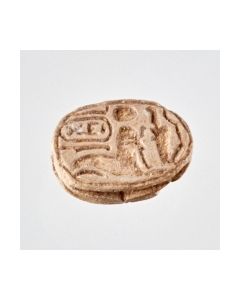 Memorial scarab for Thutmose III
Memorial scarab for Thutmose IIIA royal sphinx and Maat, the goddess of truth and justice adorn the lower side. Above them is the cartouche of Mencheperre. The piece is probably from the regin of Ramesses IV or V.
Price: on request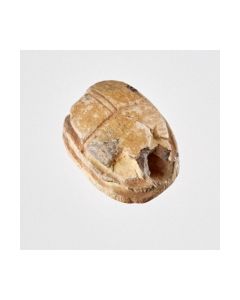 Egyptian Scarab with hieroglyphs
Egyptian Scarab with hieroglyphsInteresting scarab made of steatit with inscription for Amun. Dating to the 19th to 21st dynasty of ancient Egypt.
Price: on request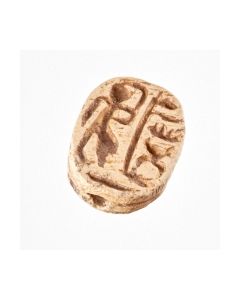 Scarab with cartouche
Scarab with cartoucheThe scarab from the late Ramesside period shows a standing person. A cartouche in front bears the name of pharao Mencheperre, who was famous as Thutmose III.
Price: on request Scarab with hieroglyphic formula
Scarab with hieroglyphic formulaThe piece is from the Second Intermediate Period. It was probably meant as a good fortune or protective amulet.
Price: on request Scarab with magic spell
Scarab with magic spellThe hieroglyphs are of the so called anra design, a magic spell in the ancient Egyptian belief. The scarab is from the 13th to 15th dynasty. It is described in the catalogue of Gautier-Vodoz.
Price: on request Scarab with pattern of circles
Scarab with pattern of circlesThe beetle stone bears a popular motive of the Middle Empire. A nice example of its kind. This scarab is described in the catalogue of Irène Gautier-Vodoz.
Price: on request Scarab with geometric motive
Scarab with geometric motiveThe motive exhibits two symmetry axes and at least six triangles. A wonderful artistic expression of the highly evolved Egyptian maths. This scarab is described in the catalogue of Irène Gautier-Vodoz.
Price: on request Scarab with geometric motive
Scarab with geometric motiveThe lower side exhibits a symmetrical arrangements of cords, two of which are wrapped around each other. This scarab is described in the catalogue of Irène Gautier-Vodoz.
Price: on request Scarab with protective formula
Scarab with protective formulaAmulet for protection. Stilized lotus flowers on the upper side. Magic formula on the lower side. This scarab is described in the catalogue of Irène Gautier-Vodoz.
Price: on request Scarab with lion
Scarab with lionThe scene shows a walking lion. It is framed by an oval cord. This scarab is described in the catalogue of Irène Gautier-Vodoz.
Price: on request Scaraboid from the Middle Kingdom
Scaraboid from the Middle KingdomThe stamp shows hieroglyphs with a title for the king of Upper and Lower Egypt. This scaraboid is described in the catalogue of Irène Gautier-Vodoz.
Price: on request Cowroid with Ankh and papyrus
Cowroid with Ankh and papyrusThe seal is engraved with the breath of life between two papyrus plants. This scaraboid is described in the catalogue of Irène Gautier-Vodoz.
Price: on request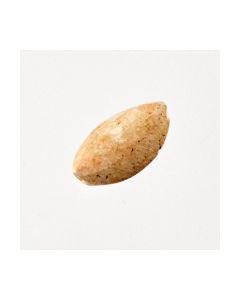 Cowroid with magic spell
Cowroid with magic spellThe hieroglyphs of the anra type are to be interpreted as magical formula. From the Second Intermediate Period of ancient Egpyt. This scaraboid is described in the catalogue of Gautier-Vodoz.
Price: on request Cowroid with decorated body
Cowroid with decorated bodyThe cowroid has an interesting decoration across the upper surface. The lower surface is inscribed with hieroglyphs. This cowroid is discussed in the catalogue of Gautier-Vodoz.
Price: on request Pre-Dynastic pottery of Ancient Egypt
Pre-Dynastic pottery of Ancient EgyptThe simple vessel is made of coarse clay. It dates to the end of the 4th millenium BC and hence witnessed the beginning of the Ancient Egyptian civilization.
Price: on request Western Asiatic button seal with hares
Western Asiatic button seal with haresInteresting button shaped seal from the time of the ancient Assyrian trade settlements in Syria and Anatolia. 19th to 18th cent. BC. From the Dr. Langenkamp collection, with a scientific note from Prof. Mayer-Opificius.
Price: on request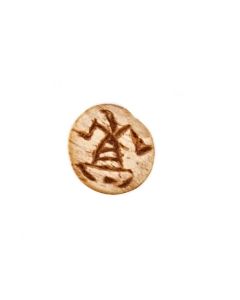 Western Asiatic button seal with scorpion
Western Asiatic button seal with scorpionInteresting button shaped seal from the time of the ancient Assyrian trade settlements in Syria and Anatolia. 19th to 18th cent. BC. From the Dr. Langenkamp collection, with a scientific note from Prof. Mayer-Opificius.
Price: on request Faience tile of the Djoser pyramid type
Faience tile of the Djoser pyramid typeEgyptian wall tile from the Old Kingdom, 2nd to 3rd dynasty. The tile type is known from the famous step pyramid of king Djoser.
Price: on request Massive Bronze Age spear head, possibly celtic
Massive Bronze Age spear head, possibly celticPerfectly preserved, large piece with beautiful patina. From an old German collection.
Price: on request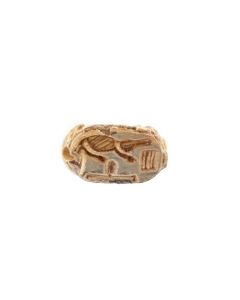 Egyptian scarab for Sobekhotep
Egyptian scarab for SobekhotepThe back of the scarboid body is shaped like a lying cat. New Kingdom of ancient Egypt, around 1000 BC.
Price: on request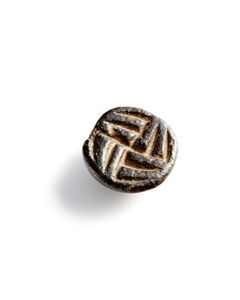 Domförmiges Stempelsiegel mit Swastika
Domförmiges Stempelsiegel mit SwastikaSüdost-Türkei oder Nord-Syrien. Spätes 4. bis frühes 3. Jt. v. Chr. Kreuz mit nach links weisenden Doppelwimpeln an den Enden. Perfekte Erhaltung.
Price: on request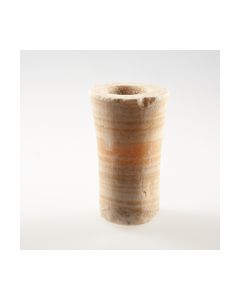 Baktrisches Alabastergefäß für kultische Zwecke
Baktrisches Alabastergefäß für kultische ZweckeSäulenartige Form, öffnet sich leicht zur Oberseite hin. In diese ist eine Mulde eingelassen. Das Gefäß ähnelt in seiner Form den baktrischen Säulenidolen.
Price: on request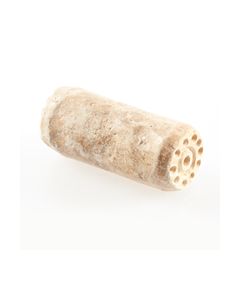 Siegel der Induskultur
Siegel der InduskulturZylinderförmiges Siegel mit geometrischer Matrix. Aus dem 3. bis 2. Jt. v. Chr., Indus-Kultur, eine der frühesten städtischen Zivilisationen. Hervorragende Erhaltung.
Price: on request Prädynastische ägyptische Keramikschale
Prädynastische ägyptische KeramikschaleSehr seltene, frühe Keramik aus der prädynastischen Naqada-Zeit Ägyptens. Etwa 4000 bis 3200 v. Chr.
Price: on request Ohrring aus Belutschistan, Indus-Kultur - Silber
Ohrring aus Belutschistan, Indus-Kultur - SilberAufwendig gearbeiteter, massiver Ohrring. In Verschlussnähe Verzierung durch Spiralen. Museales Stück, tolle, dunkle Patina.
Price: on request Sumerische Muschelperle
Sumerische MuschelperleWunderschöner Anhänger, aus einer Muschel gearbeitet. Dieses uralte Exemplar ist eine interessante Ergänzung für jede Perlensammlung.
Price: on request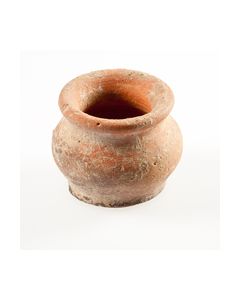 Antikes Keramikgefäß der Indus-Kultur
Antikes Keramikgefäß der Indus-KulturBauchiges Miniaturgefäß aus rotem Ton mit breiter Standfläche. Exzellente Erhaltung. Fund aus der Nähe von Udigram.
Price: on request Bronzering aus Belutschistan, Indus-Kultur
Bronzering aus Belutschistan, Indus-KulturFingerring, als Schmuck dient ein Cabochon aus Bronze. Aufwendig gearbeitetes, sehr ungewöhnliches Belegstück.
Price: on request Bronzering aus Belutschistan, Indus-Kultur
Bronzering aus Belutschistan, Indus-KulturFingerring aus Bronze, ursprünglich mit Stein geschmückt. Stein fehlt, um die Fassung Dekor aus Bronzekugeln. Aufwendig gearbeitet.
Price: on request Tonfigur eines Stiers aus Belutschistan
Tonfigur eines Stiers aus BelutschistanStilisierte Darstellung eines Stiers. 85 mm x 45 mm x 80 mm groß und fein gearbeitet. Dunkelroter Ton, 4. bis 2. Jt. v. Chr.
Price: on request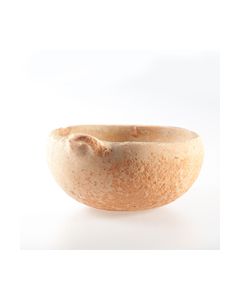 Einhenkliges Keramikgefäß aus dem heiligen Land
Einhenkliges Keramikgefäß aus dem heiligen LandTiefe Schale mit Henkel, hellroter Ton. Exzellente Erhaltung, sehr schöne Sandpatina. Aus niederländischer Sammlung.
Price: on request Vorderasiatische Pfeilspitze oder Speerspitze
Vorderasiatische Pfeilspitze oder SpeerspitzeMassiver Bronzeguss, verstärkte Mittelrippe, rechteckiger Schaft. Ca. 100mm bis 120mm lang, 2. Jt. v. Chr. bis 1. Jt. v. Chr. Ex-Guttmann, ex-Christies.
Price: on request Vorderasiatische Pfeilspitze oder Speerspitze
Vorderasiatische Pfeilspitze oder SpeerspitzeMassiver Bronzeguss, verstärkte Mittelrippe, rechteckiger Schaft. Ca. 100mm bis 120mm lang, 2. Jt. v. Chr. bis 1. Jt. v. Chr. Ex-Guttmann, ex-Christies.
Price: on request Vorderasiatische Pfeilspitze oder Speerspitze
Vorderasiatische Pfeilspitze oder SpeerspitzeMassiver Bronzeguss, verstärkte Mittelrippe, rechteckiger Schaft. Ca. 100mm bis 120mm lang, 2. Jt. v. Chr. bis 1. Jt. v. Chr. Ex-Guttmann, ex-Christies.
Price: on request Vorderasiatische Pfeilspitze oder Speerspitze
Vorderasiatische Pfeilspitze oder SpeerspitzeMassiver Bronzeguss, verstärkte Mittelrippe, rechteckiger Schaft. Ca. 100mm bis 120mm lang, 2. Jt. v. Chr. bis 1. Jt. v. Chr. Ex-Guttmann, ex-Christies.
Price: on request Einhenkliges Keramikgefäß aus dem heiligen Land
Einhenkliges Keramikgefäß aus dem heiligen LandTiefe Schale mit Henkel, heller Ton. Exzellente Erhaltung, sehr schöne Sandpatina. Aus niederländischer Sammlung.
Price: on request

